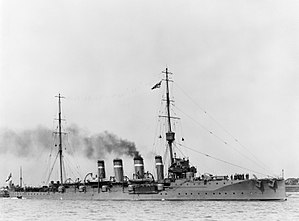
Back Глазгоу (бронепалубен крайцер) Bulgarian HMS Glasgow (1909) German HMS Glasgow (1909) Greek HMS Glasgow (1909) Spanish اچاماس گلاسگو (۱۹۰۹) Persian HMS Glasgow (1909) Finnish HMS Glasgow (1909) French HMS Glasgow (1909) Hungarian グラスゴー (軽巡洋艦・初代) Japanese HMS «Glasgow» (1909) NB
 Glasgow about 1911
| |
| History | |
|---|---|
| Name | Glasgow |
| Namesake | Glasgow |
| Builder | Fairfield Shipbuilding & Engineering, Govan |
| Laid down | 25 March 1909 |
| Launched | 30 September 1909 |
| Completed | September 1910 |
| Fate | Sold for scrap, 29 April 1927 |
| General characteristics (as built) | |
| Class and type | Town-class light cruiser |
| Displacement | 4,800 long tons (4,877 t) |
| Length | |
| Beam | 47 ft (14.3 m) |
| Draught | 15 ft 3 in (4.65 m) (mean) |
| Installed power |
|
| Propulsion | 4 × shafts; 2 × steam turbines |
| Speed | 25 kn (46 km/h; 29 mph) |
| Range | 5,830 nautical miles (10,800 km; 6,710 mi) at 10 knots (19 km/h; 12 mph) |
| Complement | 480 |
| Armament |
|
| Armour |
|
HMS Glasgow was one of five ships of the Bristol sub-class of the Town-class light cruisers built for the Royal Navy in the first decade of the 20th century. Completed in 1910, the ship was briefly assigned to the Home Fleet before she was assigned to patrol the coast of South America. Shortly after the start of the First World War in August 1914, Glasgow captured a German merchant ship. She spent the next several months searching for German commerce raiders. The ship was then ordered to join Rear Admiral Christopher Cradock's squadron in their search for the German East Asia Squadron. He found the German squadron on 1 November off the coast of Chile in the Battle of Coronel. They outnumbered Cradock's force and were individually more powerful, sinking Cradock's two armoured cruisers, although Glasgow was only lightly damaged.
The ship fell back to the coast of Brazil for repairs and to await reinforcements. They arrived in late November under the command of Vice-Admiral Doveton Sturdee and were considerably more powerful than the East Asia Squadron. After sailing to the Falkland Islands to refuel in early December, the British ships were surprised by the Germans who withdrew when they realized the number of ships that Sturdee had under his command. They pursued the retreating Germans and sank four of their five ships in the Battle of the Falkland Islands, with Glasgow helping to sink one of the German light cruisers. She was one of the ships tasked to hunt down the sole survivor which she finally did, together with another cruiser, in the Battle of Más a Tierra in March 1915.
Glasgow spent the next two years searching for commerce raiders and protecting Allied shipping off the South American coast, although she was unsuccessful in locating one commerce raider active in the South Atlantic in early 1916. The ship was transferred to the Adriatic Sea in mid-1918 and played a minor role in the Second Battle of Durazzo a few months later. She was reduced to reserve after the war ended, but later served as a training ship in 1922–1926 before she was sold for scrap in 1927.